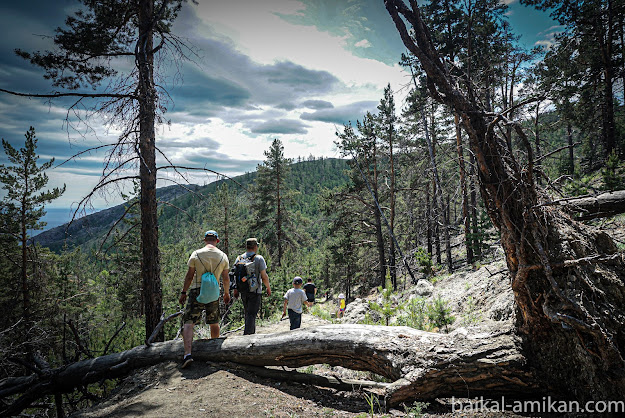Olkhon island
Olkhon land is severe. Every Olkhon villager knows it, but not likely that any tourist knows it. Every new summer more and more of them come to the island which is the most attractive place for them to visit on Baikal. For indigenous population of Olkhon this island is a sacred place, same as lake Baikal. Terrifying spirits of the Great Lake inhabit this place, this was the place where the first Buryat shaman was given the Shaman talent in ancient times, and also some believe that it is the place of Chingis-Khan burial site.
Olkhon is shrouded with myths, legends and old stories which are handed down by tradition. However, the scientific community has recognized it as the main sanctuary and the worship center of general Mongolian and Central Asian significance, and the center of the Kurumchi Culture of the 6th-9th centuries. The local discoveries include Kurumchi sites of fortified towns, burial grounds and many other archaeologican monuments, the best known of which is the ancient Kurykan’s stone wall. All these and other facts show that Olkhon has a great history. Its past is entwined with the life of the aboriginals whose principal pursuit was fishing. Its present is now tourism that became an increasingly lucrative business among Olkhon’s inhabitants. Regrettable, however, this has caused serious ecological damage to Olkhon.
Olkhon is more than 700 square km. There are some villages on it, but the biggest and the central is Khuzhir. The roads here don’t know what asphalt is. Old small wooden houses with the “house for rent” sign compete with mini-hotels and recreation bases. This is a typical village but its location is not-typical - an island, surrounded with clearest Baikal waters (and also reminding the lake by its shape!), incredible nature and unique sights. The most favourite place among tourists is Shamanka rock (or Burkhan cape) – one of the 9 sanctuaries of Asia. According to a legend, this is the palace of Khan Khoto Baabay, of one of the 13 celestials, which was sent to earth by the gods to determine the people’s fate. His son now lives on Olkhon in the form of an bald eagle.
The northernmost point of Olkhon is Khoboy cape. Its near-by rocks remind teeth, thus the name Khoboy means “the fang” in Buryat language. According to the ancient legend, the wife of one of the celestials was envious to his husband because of his palace which was given to him by the gods. And when she asked the gods to give her a palace as well – they became angry and turned her into a rock. From the seaside one may see the female outline on that rock.
Most of the villagers still survive thanks to Baikal. They go fishing. The fish that they catch they sell to tourists, but they used to give most of the fish to Malomorskiy fish plant. This only enterprise on the island provided people with jobs in the past. There were lots of fish on Olkhon area, the plant operated using its all power which gave people not only their salaries but also an electricity – a diesel station worked there. But perestroika occurred and the fish plant was not an exception among many large plants of the former Soviet union, and was fallen into decay. Local people were left without place to work and electricity. Rusty ships and old vessels which still stand at the pier, deserted half-destroyed houses and stories of old locals keep the history of those times.
The electricity came back to the island in 2005 (only!) and the problem of employment is partly solved by tourism. Most of the villagers accommodate tourists in their houses, sell fish, wood, make excursions by their UAZ cars around the island – find any possible way to earn money. The Russian proverb: “One summer day feeds the whole year” perfectly describes the situation there. The tourist season is short, that’s why people do their best to earn money during summer time so they can live in winter.
Olkhon is not the same which it used to be. Now the civilization reached that place as well. The lines of the electricity, satellite plates installed on the roofs of the wooden houses, the amount of cars and multi-national speech and dialects – made the silence disappear. The island is being build up with new hotels and tourist bases, and no villager can tell exactly whom this land belongs to. They gloom and say “to Moscow people, probably…”
I started working as a guide on this magnificent island. I spent my summer season as a tourism instructor and a guide at the yurt camp in 2003. There was no electricity, we kept all the food in so-called ground fridges – a hole in the ground stuffed with ice. There was just one road to the north of the island, and not 4-6 roads with cars overtaking each other on a high season period, and just several picnic places in the forest near Khoboy, and of course less trash there. There weren’t many guide books about legends and history of some places and I remember collecting and drafting the interesting facts in my handbook after each excursion. I remember the brightest sunsets it gifted me while I was lying on its grassy shore. I kept coming back to this island and watch the seasons change each other and the island change its outlook but preserving its beauty and charm. I can’t be tired of it as it never has the same look. I still love that place and yes it is one of my favourites, and I’m sure that it’s a magical place. At least for me and for many other people who fell in love with it.









Комментарии
Отправить комментарий